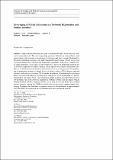Leveraging sUAS for Infrastructure Network Exploration and Failure Isolation
Author(s)
Lee, Andrew C; Dahan, Mathieu; Weinert, Andrew J; Amin, Saurabh
Download10846_2018_838_ReferencePDF.pdf (10.10Mb)
Terms of use
Metadata
Show full item recordAbstract
Abstract
Large-scale infrastructures are prone to simultaneous faults when struck by a natural or man-made event. The current operating procedure followed by many utilities needs improvement, both in terms of monitoring performance and time to repair. Motivated by the recent technological progress on small Unmanned Aerial Systems (sUAS), we propose a practical framework to integrate the monitoring capabilities of sUAS into standard utility repair operations. A key aspect of our framework is the use of monitoring locations for sUAS-based inspection of failures within a certain spatial zone (called a localization set). This set is defined based on the alerts from fixed sensors or customer calls. The positioning of monitoring locations is subject to several factors such as sUAS platform, network topology, and airspace restrictions. We formulate the problem of minimizing the maximum time to respond to all failures by routing repair vehicles to various localization sets and exploring these sets using sUAS. The formulation admits a natural decomposition into two sub-problems: the sUAS Network Exploration Problem (SNEP); and the Repair Vehicle Routing Problem (RVRP). Standard solvers can be used to solve the RVRP in a scalable manner; however, solving the SNEP for each localization set can be computationally challenging. To address this limitation, we propose a set cover based heuristic to approximately solve the SNEP. We implement the overall framework on a benchmark network.
Date issued
2018-04-26Department
Massachusetts Institute of Technology. Department of Civil and Environmental Engineering; Massachusetts Institute of Technology. Center for Computational Engineering; Lincoln LaboratoryPublisher
Springer Netherlands